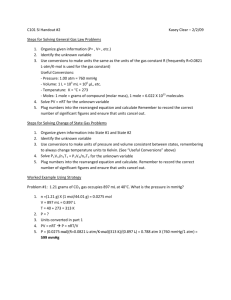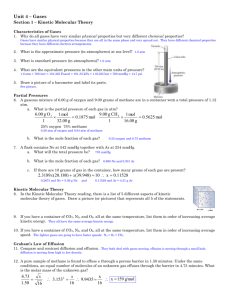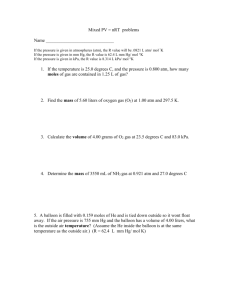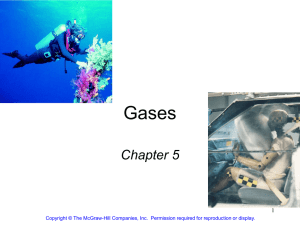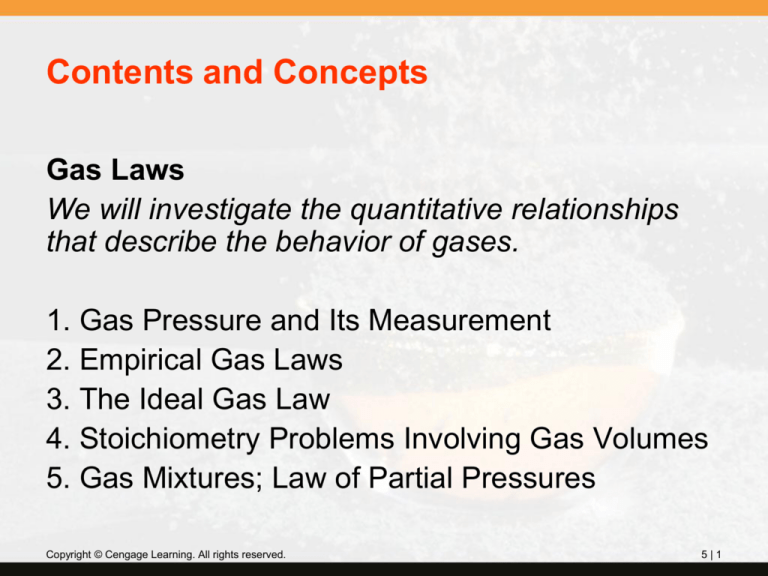
Contents and Concepts
Gas Laws
We will investigate the quantitative relationships
that describe the behavior of gases.
1. Gas Pressure and Its Measurement
2. Empirical Gas Laws
3. The Ideal Gas Law
4. Stoichiometry Problems Involving Gas Volumes
5. Gas Mixtures; Law of Partial Pressures
Copyright © Cengage Learning. All rights reserved.
5|1
Kinetic-Molecular Theory
This section will develop a model of gases as
molecules in constant random motion.
6. Kinetic Theory of Gases
7. Molecular Speeds; Diffusion and Effusion
8. Real Gases
Copyright © Cengage Learning. All rights reserved.
5|2
3
Physical Characteristics of Gases
•
Gases assume the volume and shape of their containers.
•
Gases are the most compressible state of matter.
•
Gases will mix evenly and completely when confined to
the same container.
•
Gases have much lower densities than liquids and solids.
NO2 gas
4
Gases differ from liquids and solids:
They are compressible.
Pressure, volume, temperature, and amount
are related.
Copyright © Cengage Learning. All rights reserved.
5|5
Some applications
• How does a pressure cooker
work?
• How is gas pressure applied in
spray cans?
• How does a hot air balloon
work?
• Why do we not want our tires
to be full during hot summer
days?
• Why do balloons
deflate when left
outside on a cold
weather?
Force
Pressure = Area
(force = mass x acceleration)
Units of Pressure
1 pascal (Pa) = 1 N/m2
1 atm = 760 mmHg = 760 torr
1 atm = 101,325 Pa
7
Manometers Used to Measure Gas Pressures
closed-tube
open-tube
8
Boyle’s Law
The volume of a sample of gas at constant
temperature varies inversely with the applied
pressure.
1
The mathematical relationship: V
P
In equation form:
PV constant
PiVi PfVf
Copyright © Cengage Learning. All rights reserved.
5|9
Boyle’s Law
P a 1/V
P x V = constant
P1 x V1 = P2 x V2
Constant temperature
Constant amount of gas
10
A sample of chlorine gas occupies a volume of 946 mL at a
pressure of 726 mmHg. What is the pressure of the gas (in
mmHg) if the volume is reduced at constant temperature to 154
mL?
P x V = constant
P1 x V1 = P2 x V2
P2 =
P1 = 726 mmHg
P2 = ?
V1 = 946 mL
V2 = 154 mL
P1 x V1
V2
726 mmHg x 946 mL
=
= 4460 mmHg
154 mL
11
• 1. The pressure on a 2.50 L
of anesthetic gas changes
from 105 kPa to 40.5 kPa.
What will be the new
volume if the temperature
remains constant?
• 2. A gas with a volume
of 4.00 L at a pressure
of 205 kPa is allowed to
expand to a volume of
12.0 L. What is the
pressure in the
container of the
temperature remains
constant?
Chemistry in Action:
Scuba Diving and the Gas Laws
P
Depth (ft)
Pressure
(atm)
0
1
33
2
66
3
V
13
Variation in Gas Volume with Temperature at Constant Pressure
As T increases
V increases
14
Variation of Gas Volume with Temperature
at Constant Pressure
Charles’ &
Gay-Lussac’s
Law
VaT
V = constant x T
Temperature must be
in Kelvin
V1/T1 = V2 /T2
T (K) = t (0C) + 273.15
15
A balloon was immersed
in liquid nitrogen (black
container) and is shown
immediately after being
removed. It shrank
because air inside
contracts in volume.
Copyright © Cengage Learning. All rights reserved.
As the air inside warms,
the balloon expands to
its orginial size.
5 | 16
Charles’ Law
• Volume vs. Temperature • 1. If a sample of gas
at constant pressure
occupies 6.80 L at 3250
C, what will be its
• Volume is directly
0C if the
volume
at
25
proportional to
pressure does not
temperature
change?
• Vα T @ constant P
Note: convert Celsius to
• V=kT; V/T= k
Kelvin scale by adding
• V1/T1 = V2/T2
273 to the given 0C.
• 2. Exactly 5.00 L of air at
-50.00C is warmed to
100.00C. What is the
new volume if the
pressure remains
constant?
A sample of carbon monoxide gas occupies 3.20 L at 125 0C.
At what temperature will the gas occupy a volume of 1.54 L if
the pressure remains constant?
V1 /T1 = V2 /T2
V1 = 3.20 L
V2 = 1.54 L
T1 = 398.15 K
T2 = ?
T1 = 125 (0C) + 273.15 (K) = 398.15 K
T2 =
V2 x T1
V1
=
1.54 L x 398.15 K
3.20 L
= 192 K
19
Gay-Lussac’s Law
• Pressure and
Temperature at
constant Volume
• P is proportional to T @
constant volume
• PαT @ constant V
• P=kT; P/T=k
• P1/T1 = P2/T2
• A gas has a pressure of
6.58 kPa at 539K. What
will be the pressure at
211 K if the volume
does not change?
• The pressure in an
automobile tire is 198
kPa at 270C. At the end
of a trip on a hot sunny
day, the pressure has
risen to 225 kPa. What
is the temperature of
the air in the tire?
• Helium gas in a 2.00-L
cylinder is unter 1.12
atm pressure. At 36.5
0C, that same gas
sample has a pressure
of 2.56 atm. What was
the initial temperature
of the gas?
Avogadro’s Law
V a number of moles (n)
Constant temperature
Constant pressure
V = constant x n
V1 / n1 = V2 / n2
22
Avogadro’s Principle
• Volume is proportional to number of moles
• V α n where n is the number of moles
• More moles occupy greater volume
Ammonia burns in oxygen to form nitric oxide (NO) and water
vapor. How many volumes of NO are obtained from one volume
of ammonia at the same temperature and pressure?
4NH3 + 5O2
1 mole NH3
4NO + 6H2O
1 mole NO
At constant T and P
1 volume NH3
1 volume NO
24
Combined Gas Law
• PαT
V
P=k T
V
PV = k
T
• At 0.000C and 1.00 atm
pressure a sample of gas
occupies 30.0 mL. if the
temperature is increased
30.00C and the gas sample is
transferred to 20.0 mL
container, what is the gas
pressure?
Standard Temperature and Pressure (STP)
The reference condition for gases, chosen by
convention to be exactly 0°C and 1 atm pressure.
The molar volume, Vm, of a gas at STP is 22.4
L/mol.
The volume of the
yellow box is 22.4 L. To
its left is a basketball.
Copyright © Cengage Learning. All rights reserved.
5 | 26
STP
• At STP,
• T=00C or 273 K
• P= 1atm
• At Standard
temperature and
pressure, molar volume
is 22.4 L
• Meaning, 1 mole of any
gas occupies 22.4 liters
at STP
Ideal Gas Law
• Ideal gas behaves as if there is no IMF present
among the molecules of gas.
• PV = R
nT
R = 1atm (22.4L)
1 mole ( 273)
R= .0821 atm-L/mol-K
Ideal Gas Equation
Boyle’s law: P a 1 (at constant n and T)
V
Charles’ law: V a T (at constant n and P)
Avogadro’s law: V a n (at constant P and T)
Va
nT
P
V = constant x
nT
P
=R
nT
P
R is the gas constant
PV = nRT
29
What is the volume (in liters) occupied by 49.8 g of HCl at STP?
T = 0 0C = 273.15 K
P = 1 atm
PV = nRT
nRT
V=
P
1 mol HCl
n = 49.8 g x
= 1.37 mol
36.45 g HCl
1.37 mol x 0.0821
V=
L•atm
mol•K
x 273.15 K
1 atm
V = 30.7 L
30
Sample problems for Ideal gas law
• If the pressure exerted
by the gas at 250C in a
volume of 0.044 L is
3.81 atm, how many
moles of gas are
present?
• Determine the celsius
temperature of 2.49
moles of gas contained
in a 1.00-L vessek at a
pressure of 143 kPa.
Density (d) Calculations
PM
m
d=
=
V
RT
m is the mass of the gas in g
M is the molar mass of the gas
Molar Mass (M ) of a Gaseous Substance
dRT
M=
P
d is the density of the gas in g/L
32
A 2.10-L vessel contains 4.65 g of a gas at 1.00 atm and 27.0
0C. What is the molar mass of the gas?
dRT
M=
P
M=
g
2.21
L
4.65 g
m
=
= 2.21
d=
2.10
L
V
x 0.0821
L•atm
mol•K
g
L
x 300.15 K
1 atm
M = 54.5 g/mol
33
Density of gas from ideal gas equation
•
•
•
•
•
•
•
•
•
D=M/V
V=M/D
PV=nRT
P(Mass/D)= nRT
Since n= mass/MW
Then,
P(Mass/D)=(Mass/MW)RT
Therefore: P(MW)=DRT
D=P(MW)
RT
• What is the density of a
gas at STP that has a
molar mass of 44.0
g/mol?
D=1atm(44.0g/mol)
.0821 (273K)
D= 1.96 g/L
Stoichiometry and Gas Volumes
Use the ideal gas law to find moles from a given
volume, pressure, and temperature, and vice
versa.
Copyright © Cengage Learning. All rights reserved.
5 | 35
Gas Stoichiometry
What is the volume of CO2 produced at 37 0C and 1.00 atm
when 5.60 g of glucose are used up in the reaction:
C6H12O6 (s) + 6O2 (g)
6CO2 (g) + 6H2O (l)
g C6H12O6
mol C6H12O6
5.60 g C6H12O6 x
6 mol CO2
1 mol C6H12O6
x
= 0.187 mol CO2
180 g C6H12O6
1 mol C6H12O6
V=
nRT
=
P
mol CO2
V CO2
L•atm
x 310.15 K
mol•K
1.00 atm
0.187 mol x 0.0821
= 4.76 L
36
Gas Mixtures
Dalton found that in a mixture of unreactive gases,
each gas acts as if it were the only gas in the
mixture as far as pressure is concerned.
Copyright © Cengage Learning. All rights reserved.
5 | 37
Dalton’s Law of Partial Pressures
V and T are constant
P1
P2
Ptotal = P1 + P2
38
Consider a case in which two gases, A and B, are in a
container of volume V.
nART
PA =
V
nA is the number of moles of A
nBRT
PB =
V
nB is the number of moles of B
PT = PA + PB
PA = XA PT
nA
XA =
nA + nB
nB
XB =
nA + nB
PB = XB PT
Pi = Xi PT
mole fraction (Xi ) =
ni
nT
39
A sample of natural gas contains 8.24 moles of CH4, 0.421
moles of C2H6, and 0.116 moles of C3H8. If the total pressure
of the gases is 1.37 atm, what is the partial pressure of
propane (C3H8)?
Pi = Xi PT
PT = 1.37 atm
0.116
Xpropane =
8.24 + 0.421 + 0.116
= 0.0132
Ppropane = 0.0132 x 1.37 atm = 0.0181 atm
40
A 100.0-mL sample of air exhaled from the
lungs is analyzed and found to contain
0.0830 g N2, 0.0194 g O2, 0.00640 g CO2,
and 0.00441 g water vapor at 35°C. What
is the partial pressure of each component
and the total pressure of the sample?
Copyright © Cengage
Learning. All rights
5 | 41
1 mol N2
0.0830 g N2
28.01 g N2
L atm
0.08206
308 K
mol K
0.749 atm
PN2
100.0 mL 13L
10 mL
1 mol O 2
L atm
0.0194 g O 2
0.08206
308 K
32.00 g O 2
mol K
0.153 atm
PO2
100.0 mL 13L
10 mL
1 mol CO2
L atm
0.00640 g CO2
0.08206
308 K
44.01 g CO2
mol K
0.0368 atm
PCO2
100.0 mL 13L
10 mL
1 mol H2 O
L atm
0.00441 g H2 O
0.08206
308 K
18.01
g
H
O
mol
K
2
0.0619 atm
PH2O
1L
100.0 mL 3
10 mL
Copyright © Cengage Learning.
5 | 42
All rights reserved.
PN2 0.749 atm
PO2 0.153 atm
PCO2 0.0368 atm
PH2O 0.0619 atm
P PN2 PO2 PCO2 PH2O
P = 1.00 atm
Copyright © Cengage
Learning. All rights
5 | 43
The partial pressure of air in the alveoli
(the air sacs in the lungs) is as follows:
nitrogen, 570.0 mmHg; oxygen, 103.0
mmHg; carbon dioxide, 40.0 mmHg; and
water vapor, 47.0 mmHg. What is the mole
fraction of each component of the alveolar
air?
PN2 570.0 mmHg
PO2 103.0 mmHg
PCO2 40.0 mmHg
PH2O 47.0 mmHg
Copyright © Cengage Learning.
All rights reserved.
5 | 44
P PN2 PO2 PCO2 PH2O
570.0 mmHg
103.0 mmHg
40.0 mmHg
47.0 mmHg
P = 760.0 mmHg
Copyright © Cengage Learning.
All rights reserved.
5 | 45
Mole fraction of N2
570.0 mmHg
760.0 mmHg
Mole fraction of O2
103.0 mmHg
760.0 mmHg
Mole fraction of CO2
40.0 mmHg
760.0 mmHg
Mole fraction of H2O
47.0 mmHg
760.0 mmHg
Mole fraction N2 = 0.7500
Mole fraction O2 = 0.1355
Mole fraction CO2 = 0.0526
Mole fraction O2 = 0.0618
Copyright © Cengage
Learning. All rights
5 | 46
Collecting a Gas over Water
2KClO3 (s)
2KCl (s) + 3O2 (g)
PT = PO2 + PH2 O
47
Collecting Gas Over Water
Gases are often collected over water. The result is
a mixture of the gas and water vapor.
The total pressure is equal to the sum of the gas
pressure and the vapor pressure of water.
The partial pressure of water depends only on
temperature and is known (Table 5.6).
The pressure of the gas can then be found using
Dalton’s law of partial pressures.
Copyright © Cengage Learning. All rights reserved.
5 | 48
Vapor of Water and Temperature
49
50
?
You prepare nitrogen gas by heating
ammonium nitrite:
NH4NO2(s) N2(g) + 2H2O(l)
If you collected the nitrogen over water
at 23°C and 727 mmHg, how many
liters of gas would you obtain from 5.68
g NH4NO2?
P = 727 mmHg
Pvapor = 21.1 mmHg
Pgas = 706 mmHg
T = 23°C = 296 K
Copyright © Cengage Learning. All rights reserved.
Molar mass NH4NO2
= 64.06 g/mol
5 | 51
P = 727 mmHg
Pvapor = 21.1 mmHg
Pgas = 706 mmHg
T = 23°C = 296 K
Molar mass NH4NO2
= 64.06 g/mol
nRT
V
P
1mol NH4NO2
1mol N2
5.68 g NH4NO2
64.04 g NH4NO2 1mol NH4NO2
= 0.8887 mol N2 gas
Copyright © Cengage Learning. All rights reserved.
5 | 52
P = 727 mmHg
Pvapor = 21.1 mmHg
Pgas = 706 mmHg
T = 23°C = 296 K
n = 0.0887 mol
nRT
V
P
L atm
0.0887 mol 0.08206
(296 K)
mol K
V
1 atm
706 mmHg
760 mmHg
= 2.32 L of N2
(3 significant figures)
Copyright © Cengage Learning. All rights reserved.
5 | 53
Kinetic-Molecular Theory (Kinetic Theory)
A theory, developed by physicists, that is based on
the assumption that a gas consists of molecules in
constant random motion.
Kinetic energy is related to the mass and velocity:
1
EK mv 2
2
m = mass
v = velocity
Copyright © Cengage Learning. All rights reserved.
5 | 54
Postulates of the Kinetic Theory
1. Gases are composed of molecules whose
sizes are negligible.
2. Molecules move randomly in straight lines in all
directions and at various speeds.
3. The forces of attraction or repulsion between
two molecules (intermolecular forces) in a gas
are very weak or negligible, except when the
molecules collide.
4. When molecules collide with each other, the
collisions are elastic.
5. The average kinetic energy of a molecule is
proportional to the absolute temperature.
Copyright © Cengage Learning. All rights reserved.
5 | 55
An elastic collision is one in which no kinetic
energy is lost. The collision on the left causes the
ball on the right to swing the same height as the
ball on the left had initially, with essentially no loss
of kinetic energy.
Copyright © Cengage Learning. All rights reserved.
5 | 56
Kinetic theory of gases and …
• Compressibility of Gases
• Boyle’s Law
P a collision rate with wall
Collision rate a number density
Number density a 1/V
P a 1/V
• Charles’ Law
P a collision rate with wall
Collision rate a average kinetic energy of gas molecules
Average kinetic energy a T
PaT
57
Kinetic theory of gases and …
• Avogadro’s Law
P a collision rate with wall
Collision rate a number density
Number density a n
Pan
• Dalton’s Law of Partial Pressures
Molecules do not attract or repel one another
P exerted by one type of molecule is unaffected by the
presence of another gas
Ptotal = SPi
58
Molecular Speeds
According to kinetic theory, molecular speeds vary
over a wide range of values. The distribution
depends on temperature, so it increases as the
temperature increases.
Root-Mean Square (rms) Molecular Speed, u
A type of average molecular speed, equal to the
speed of a molecule that has the average
molecular kinetic energy
3RT
u
Mm
Copyright © Cengage Learning. All rights reserved.
5 | 59
The distribution of speeds
of three different gases
at the same temperature
The distribution of speeds
for nitrogen gas molecules
at three different temperatures
urms =
M
3RT
60
When using the equation
R = 8.3145 J/(mol · K).
T must be in Kelvins
Mm must be in kg/mol
Copyright © Cengage Learning. All rights reserved.
5 | 61
?
What is the rms speed of carbon
dioxide molecules in a container at
23°C?
T = 23°C = 296 K
CO2 molar mass =
0.04401 kg/mol
Copyright © Cengage Learning. All rights reserved.
u rms
3RT
Mm
5 | 62
Recall
kg m 2
J
s2
u rms
kg m 2
2
296 K
3 8.3145 s
mol K
kg
0.04401
mol
urms
2
m
5
1.68 10 2
s
urms
Copyright © Cengage Learning. All rights reserved.
m
4.10 10
s
2
5 | 63
Gas diffusion is the gradual mixing of molecules of one gas
with molecules of another by virtue of their kinetic properties.
r1
r2
=
M2
M1
molecular path
NH4Cl
NH3
17 g/mol
HCl
36 g/mol
64
Diffusion
The process whereby
a gas spreads out
through another gas
to occupy the space
uniformly.
Below NH3 diffuses
through air. The
indicator paper tracks
its progress.
Copyright © Cengage Learning. All rights reserved.
5 | 65
Effusion
The process by which a gas flows through a small
hole in a container. A pinprick in a balloon is one
example of effusion.
Copyright © Cengage Learning. All rights reserved.
5 | 66
Graham’s Law of Effusion
At constant temperature and pressure, the rate of
effusion of gas molecules through a particular hole
is inversely proportional to the square root of the
molecular mass of the gas.
rate of effusion of molecules
Copyright © Cengage Learning. All rights reserved.
1
Mm
5 | 67
?
Both hydrogen and helium have been
used as the buoyant gas in blimps. If a
small leak were to occur, which gas
would effuse more rapidly and by what
factor?
1
Rate H2
Rate He
2.016
1
4.002
2.016
4.002
Hydrogen will diffuse more quickly by a factor of 1.4.
Copyright © Cengage Learning. All rights reserved.
5 | 68
Deviations from Ideal Behavior
1 mole of ideal gas
PV = nRT
PV = 1.0
n=
RT
Repulsive Forces
Attractive Forces
69
Real Gases
At high pressure the relationship between pressure
and volume does not follow Boyle’s law. This is
illustrated on the graph below.
Copyright © Cengage Learning. All rights reserved.
5 | 70
At high pressure, some of the assumptions of the
kinetic theory no longer hold true:
1. At high pressure, the volume of the gas
molecule (Postulate 1) is not negligible.
2. At high pressure, the intermolecular forces
(Postulate 3) are not negligible.
Copyright © Cengage Learning. All rights reserved.
5 | 71
Effect of intermolecular forces on the pressure exerted by a gas.
72
Van der Waals Equation
An equation that is similar to the ideal gas law, but
which includes two constants, a and b, to account
for deviations from ideal behavior.
The term V becomes (V – nb).
The term P becomes (P + n2a/V2).
Values for a and b are found in Table 5.7
n 2a
P
V nb nRT
2
V
Copyright © Cengage Learning. All rights reserved.
5 | 73
Van der Waals equation
nonideal gas
2
an
( P + V2 ) (V – nb) = nRT
}
}
corrected
pressure
corrected
volume
74
Use the van der Waals equation to calculate
the pressure exerted by 2.00 mol CO2 that
has a volume of 10.0 L at 25°C. Compare
this with value with the pressure obtained
from the ideal gas law.
n = 2.00 mol
V = 10.0 L
T = 25°C = 298 K
Copyright © Cengage Learning. All rights reserved.
For CO2:
a = 3.658 L2 atm/mol2
b = 0.04286 L/mol
5 | 75
n = 2.00 mol
V = 10.0 L
T = 25°C = 298 K
Ideal gas law:
nRT
P
V
2.00 mol 0.08206 L atm (298 K)
P
mol K
10.0 L
= 4.89 atm
(3 significant figures)
Copyright © Cengage Learning. All rights reserved.
5 | 76
n = 2.00 mol
V = 10.0 L
T = 25°C = 298 K
For CO2:
a = 3.658 L2 atm/mol2
b = 0.04286 L/mol
nRT
n2a
P
2
V nb V
L2 atm
2
L atm
2.00 mol 0.08206
298 K 2.00 mol 3.658
2
mol
mol
K
P
L
10.0 L 2
10.0 L 2.00 mol 0.04286
mol
P 4.933 atm 0.146 atm
Pactual = 4.79 atm
(3 significant figures)
Copyright © Cengage Learning. All rights reserved.
5 | 77


